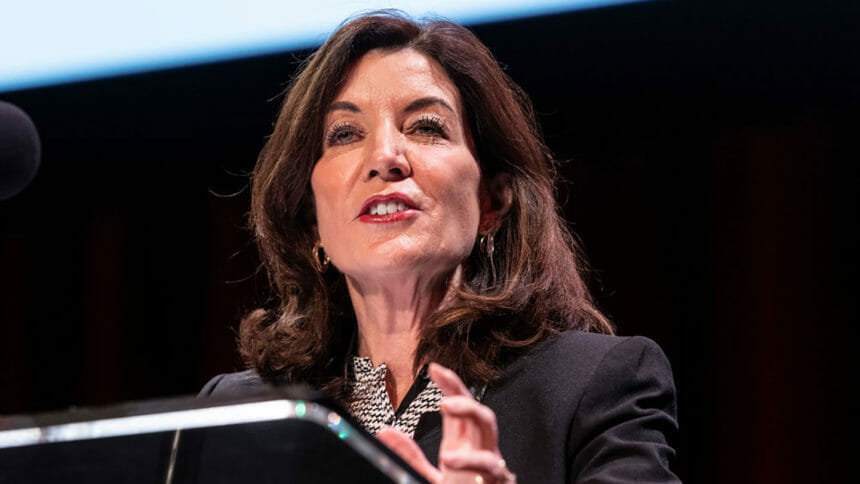
Labor and management are in lockstep that the 5% Medicaid reimbursement increase proposed by New York’s governor will not do nearly enough to alleviate the pressures facing nursing homes.
“I truly believe that we will very soon face the very difficult but real decision on permanent bed closures in this community and all the things that go along with that, including layoffs,” said John Murray, chief financial officer of Syracuse-based Loretto.
Murray’s comments came during a legislative forum hosted by 1199SEIU on the significant gap between Medicaid reimbursements and the cost of care. The long-term care sector wants a 20% increase in reimbursements, which would fall short of closing the gap but would help providers better handle costs and hopefully stem their losses.
Loretto is an affiliation of a nonprofit organizations that collectively have more than 900 nursing home beds, with 70% of residents reliant on Medicaid. The group had more than 2,400 employees pre-pandemic, many of whom lived in the “most impoverished areas” of Syracuse. Murray said it was common for multiple members of families to work at Loretto. The group is down to approximately 1,800 employees and has taken 130 beds offline.
Murray said the 5% hike proposed by Gov. Kathy Hochul (D) (pictured) won’t cover Loretto’s inflationary costs, let alone others.
Scott West, regional vice president of the McGuire Group, Absolute Care, and Taconic Health Care, said that it’s remarkable how nursing homes have come to specialize in ventilator care, telemetry, dementia, behavioral units, and dialysis. But the paltry 1% increase in Medicaid rates that facilities have seen since 2008 has not kept pace with a 25% increase in wages and benefits.
“The current model is not sustainable,” West said.
Down(state) is up
Patricia O’Connor, vice president of long-term care operations at Catholic Health, said the nonprofit health system suffered a $175 million loss last year largely due to the “inadequate” reimbursement rate. They “dug into” savings and used funds set aside for facility repairs, expansion, program development and other services to keep the health system, which includes four “highly-rated” nursing homes with 484 beds, running, O’Connor said. She explained that cost increases for supplies were up 20%, energy costs were up 17%, and drug costs were up 44%.
Last year, Catholic Health spent more than $10 million on agency staffing, O’Connor said.
New York’s Medicaid reimbursement rates vary throughout the state with downstate, which includes New York City, coming out the big winner, comparatively speaking. Downstate facilities currently receive an average of $299 per day per Medicaid resident and just 11% of SNFs there fall below the statewide median rate of $249 per day, according to information presented by SEIU.
Nursing homes in the Hudson Valley, on the other hand, get an average of $242 per Medicaid resident day, and 71% of facilities there are below the statewide median. Upstate and western New York facilities receive an average $214 per Medicaid resident day, and 90% of nursing homes fall below the median daily average.
O’Conner said Catholic Health, which serves western New York, receives $207 per Medicaid resident per day, but the cost of care is more than $357 – an operating loss of more than $150 per day.
Closure concerns
The lower wages correlate to higher staff turnover, the union said. Closures are also a concern.
Downstate facilities have an average total nursing staff turnover of 36% while the Hudson Valley and upstate/western New York regions both have turnover rates of 55%.
“We face greater competition than we ever have for entry-level employees,” O’Connor said during the forum. “[Our staffers] deserve more than someone who’s, frankly, flipping hamburgers. They’re taking care of human beings.”
‘Situation is just out of hand’
Robert Mayer, president and CEO of Weinberg Campus in Amherst, said the sector is at a “defining moment.”
“The whole situation is just out of hand,” Mayer said, as he relayed a story about a recent emergency room visit for a family member during which he overheard hospital staff struggling to find a placement for an elderly man that was less than 40 miles away.
Weinberg Campus supports 180 beds for long-term care. Mayer said the health system used to make up revenue shortfalls through reserves but without “some major increases” in Medicaid reimbursements, they face closing facilities or taking beds offline.
“I’m nervous about the future,” he said. “I’m usually a very optimistic person … but without significant reimbursement [increases], I just don’t know how we’re going to figure this out.”




